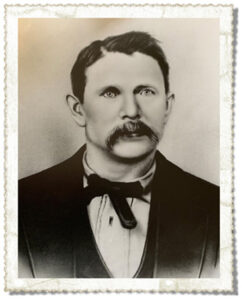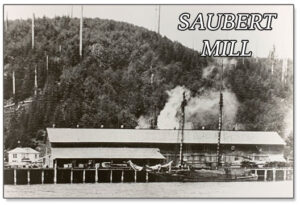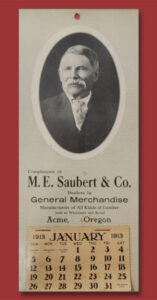DR. J. F. WILLIAM SAUBERT
Oral History Project
Part 1 of 2021 Interview with Steve Saubert
THE EARLY YEARS
In the 1880’s, travel to the Siuslaw River was hardly an easy task. Some describe it as a journey that took determination and “grit”. Pioneers came by horse, or stagecoach over rough trails barely wide enough for wagon wheels. Some crossed sand dunes, others came by boat, (depending on tide), still others simply walked from the last train stop.
 John Frederick (“J. F.”) William Saubert was born in Germany and graduated from medical school at the Chicago Homeopathic College. He began his medical practice in Wisconsin before moving to Roseburg, Oregon in 1878. He practiced there for a number of years until he was encouraged to move to the Siuslaw River. In about 1885, Dr. Saubert and his wife Mary were among the early pioneers to the Acme area (later renamed Cushman). However, Dr. Saubert soon found few people there and not enough patients to make a living from his medical practice.
John Frederick (“J. F.”) William Saubert was born in Germany and graduated from medical school at the Chicago Homeopathic College. He began his medical practice in Wisconsin before moving to Roseburg, Oregon in 1878. He practiced there for a number of years until he was encouraged to move to the Siuslaw River. In about 1885, Dr. Saubert and his wife Mary were among the early pioneers to the Acme area (later renamed Cushman). However, Dr. Saubert soon found few people there and not enough patients to make a living from his medical practice.
An industrious man, Dr. Saubert employed 6 men to build the first lumber mill (Saubert Mill) in the area. Logging  was done on the hillside above Acme. The mill was run by steam power and could produce 40,000 feet of lumber in a day. Lumber was shipped to San Francisco on boats (two and three-masted schooners). The boats would return to Acme with groceries, staples and supplies. Dr. Saubert’s wife Mary, operated the general store for several years.
was done on the hillside above Acme. The mill was run by steam power and could produce 40,000 feet of lumber in a day. Lumber was shipped to San Francisco on boats (two and three-masted schooners). The boats would return to Acme with groceries, staples and supplies. Dr. Saubert’s wife Mary, operated the general store for several years.
 The Sauberts continued to live on the hill property above Acme, where their son Roy Acme was born in 1887. Although 1900 and 1910 census records list his occupation as “Physician”, Dr. Saubert was in all likelihood, a “part-time” physician. In about 1912, Dr. Saubert and Roy built a two-story family ranch house on the hill. Clear-cut fir and square nails were used for the project.
The Sauberts continued to live on the hill property above Acme, where their son Roy Acme was born in 1887. Although 1900 and 1910 census records list his occupation as “Physician”, Dr. Saubert was in all likelihood, a “part-time” physician. In about 1912, Dr. Saubert and Roy built a two-story family ranch house on the hill. Clear-cut fir and square nails were used for the project.
Roy went on to build and operate a fish and ice plant. Ideally located, it stood near the train track. Salmon was packed in ice and sent by train to the valley.
ACME IS RENAMED CUSHMAN
Dr. Saubert is credited with naming the area Acme and among his other enterprises, became its Postmaster for 13 years. In 1916 when the railroad was built, it was determined another station was named Acme, and the name became Cushman. When the post office moved further west that year it retained the name Cushman.
Logging and lumber operations soon became the major industries for the area. With the expansion of the timber industry, other mills began operation. They included Bester & Vaughn, Yellow Fir, and LaDuke Lumber Company.
STEVEN SAUBERT, GREAT-GRANDSON
Steven (“Steve”) was born in Portland (02 April 1943) where his father, Clifton S. Saubert taught Industrial Arts. When Steve was 3 years old, the family returned to live in the Cushman area.
Steve recalls helping to remodel his great-grandfather’s home with his father to remove the second story and attic. He has vivid memories of laboring with a pick and shovel to dig out the daylight basement from the clay soil. His sister continues to live in that house today.
There were other days to be remembered as well. Just as a fishing hole can be a young boy’s secret, so too can a special muddy, productive clamming spot. Such was the case for 13-year old Steve in about 1957. He remembers digging for clams in a favorite area and coming home with between 500 and 1,000 clams! A regular clam license allowed four dozen as the limit. Steve however, was fortunate to have a commercial clam license. allowing him a larger quantity. He wasn’t fond of digging in the mud for clams, but did so because his mother enjoyed making clam chowder.
THE FLOODS OF 1960’s
There was a heavy rain the night before, and by morning the river under the Cushman railroad trestle flooded. With the water level so high cars became flooded and would ultimately stall on the road. On their way to school, Steve and his friends used chains to help tow vehicles with a 1948 truck that stood high off the ground. A reporter from the Siuslaw News was on site and took a picture of the cars and Steve. The picture appeared in the next edition of the paper. That week Steve was summoned to the school principal’s office to explain his absence from school that day. In the end, he was given a reprieve for his efforts.
Steve’s grandparents, Roy and Hannah eventually gave up the fish and ice business in Cushman. They relocated the family to the hill above what is now known as Sea Lion Caves. They were among the original three partners who began their highly successful business in 1932.
In Part 2 of the Steve Saubert interviews (September 17, 2021), he discussed the Sea Lion Caves.
View the Steve Saubert story.
